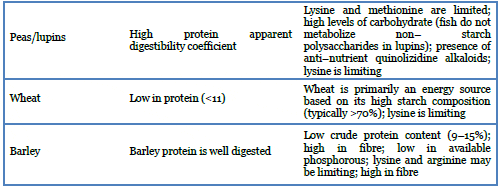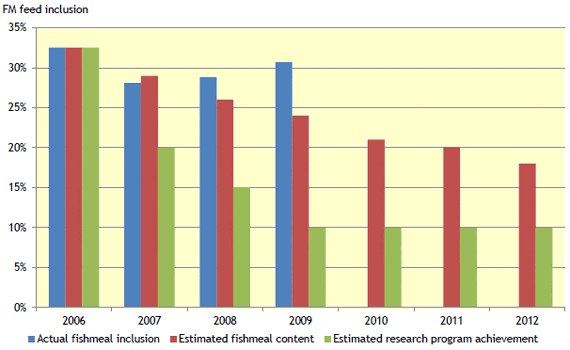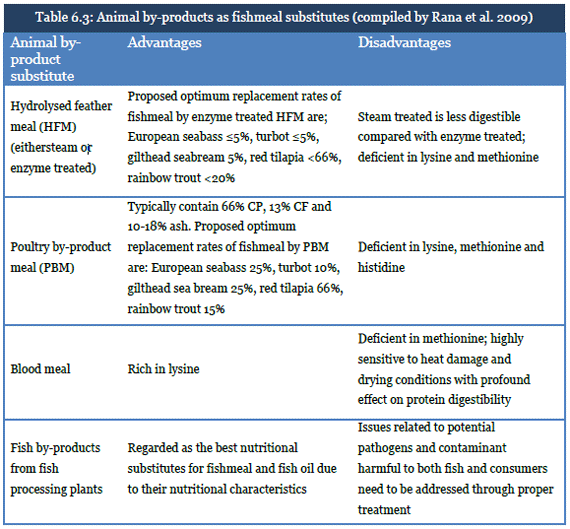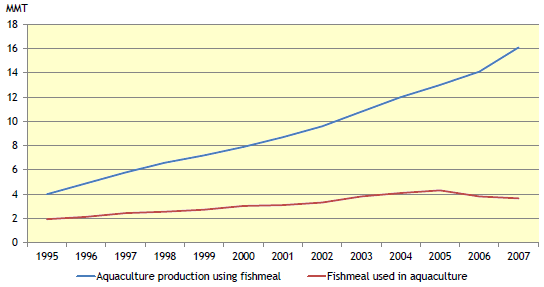Fishmeal is valued by aquaculture producers not only for its protein. Other appreciated factors include an ideal amino acid profile, high digestibility, lack of anti-nutritional factors and a high palatability. In the search for viable alternative feedstuffs to fishmeal for aquafeeds, candidate ingredients must possess one or several of the mentioned characteristics, in addition to wide availability, competitive price, as well as ease of handling, shipping storage and use in feed production (Gatlin et al. 2007).
Intensify the use of vegetable proteins
As fishmeal prices have increased, there has been a trend towards replacing fishmeal with alternate sources and in particular vegetable plant material (e.g. soybean meal, canola meal, corn meal, etc.). Compared to fishmeal, these products are believed to be in abundance at a more reasonable price. Soybean meal production is for example 25 times the fishmeal production, while prices are currently (year 2011) about a quarter. However, replacing fishmeal with these substitutes is not straightforward.
Table 6.1, reproduced from FAO's paper "Impact of rising feed ingredient prices on aquafeeds and aquaculture production" (Rana et al. 2009), summarizes the product advantages and disadvantages in fishmeal substitution. Overall, the main advantage is a high content of proteins, and some of the plant materials have also shown to be highly digestible for carnivorous fish species. There are however serious drawbacks of using plant materials instead of fishmeal, including a lower level of Omega-3 acids and anti-nutritional factors. Anti-nutritional factors are substances which reduce an organisms. growth and hence it will extend the time it takes for a fish to reach mature age. On a general basis, their presence in untreated foodstuff results in anorexia and poor food conversion when used at high dietary concentrations. The presence of endogenous anti-nutritional factors within plant feedstuffs is believed to be the largest single factor limiting their use within compounded animal and fish feeds at high dietary levels (Tacon 1985).



So if vegetable proteins are to be used more heavily in fish feed production, techniques and procedures aimed at reducing their anti-nutritional effects must be applied. Applying heat to the mixture is one approach, but that will only get you so far.
The French National Institute for Agriculture Research has initiated a research program called PEPPA (Perspectives of Plant Protein Use in Aquaculture) under the fifth framework of EU. The goal of this program is to reduce the dependency of fishmeal (and fish oil) in aquaculture production. Their targeted dependency ratio is presented in table 6.2. The project is still ongoing and they highlight that resolving the issue with anti-nutritional factors in plant proteins is a main goal. For salmon they project an inclusion rate of about 1/3 of today's rate, while for carp (which is heavily cultured in Asia) they estimate a diet without any use of fishmeal.

The fish feed producer EWOS also has a corresponding research program for their salmon feed pellets, where they aim to replace costly fishmeal with plant materials. The blue bars represent EWOS' actual fishmeal inclusion rate in feed pellets reported in Cermaq's 2009 annual report (Cermaq 2010). The red bars show what they estimated in 2006 that the future inclusion level would be, the blue bars show actual inclusion level, while the green bars show what they projected that their research program would yield. The data shows that EWOS used slightly less fishmeal than estimated in 2007, but in 2008 and 2009 they used far more than estimated. This has happened despite an increasing fishmeal-soybean meal ratio over the period. So the fishmeal inclusion level has not progressed as they estimated in 2006. However, this is probably not enough evidence to conclude that the research has progressed slower than anticipated, as it might be a simple economic decision to deviate from the stipulated plan. EWOS' goal is set at 10 percent inclusion, which puts them slightly below PEPPA's target rate at 12 - 16 percent.
EWOS Actual and Targeted Inclusion Rates (Cermaq 2010 and EWOS 2009)

Plankton and algae
A research area that lately has received a lot of attention is the prospects of substituting fishmeal with microbial and plankton products. If this research is successful it will enable producers to skip a link in the energy chain: Pelagic fish that are ground to fishmeal have a high degree of fatty acid and proteins, but these valued substances are not produced by the fish itself. Rather, herbivorous consumers obtain it from consuming plankton, including copepods, euphausiids, krill and amphipods.
The Norwegian University of Science and Technology (NTNU) initiated in 2001 a research program called Calanus aimed at identifying opportunities for harvesting zoo plankton. The main objective of the program was to map the sustainable harvesting potential, develop efficient harvesting techniques and industrial processes, and evaluate the nutritional properties of raw materials with respect to fish feed. The research program is done at a basic level and not yet commercially viable. If successful however, the possibilities for the fish feed industry are remarkable as the ocean contains vast resources of herbivorous zooplankton. In the Norwegian Sea it is estimated to be 8 – 13 grams dry weight zooplankton per m2 (Ellertsen et al. 1999 and Hassel 1999) and total production of the zooplankton Calanus is calculated at 21 million tons per year (Aksnes and Tande 1996 and Tande 1994). The Calanus biomass is of particular interest because it is highly similar to the natural diet of many feed fishes. However, developing catching methods for zooplankton is not straightforward. If the plankton is to be caught by a trawler, it will require nets with a mesh sizes at maximum 1 – 2 mm, which means high energy costs due to drag. In addition, a fine-meshed net like that has the capacity to take a bycatch consisting of virtually everything in its path.
Research on this area is still at an early stage, but if it should prove to be a commercially viable solution it will be a major catalyst for further aquaculture growth. According to the program's researchers, exploitation of zooplankton resources is probably the fastest and most sustainable way to enhance marine harvest of bio-resources for fish feed (FHF 2003).
Terrestrial insects and worms
Plankton and algae are not the only invertebrates that could be a viable protein source to replace fishmeal: Terrestrial insects and polychaete worms are also feasible sources. Examples of polychaetes are marine worms and earth worms. Earth worms contain on a dry basis 60-70 percent protein with high essential amino acid content, especially lysine and methionine. They also have 6-11 percent fat, 5-21 percent carbohydrate, 2-3 percent minerals and several vitamins. Among terrestrial insects, silkworm pupae, which contain a high content of free fatty acids, can be used.
The worms' nutrient content are thus to a large extent in line with the requirements to be a valid substitute for fishmeal. Therefore these worms are a potentially viable source of protein if they can be produced and processed economically. Researchers at the Institute of Aquaculture at the University of Stirling in Scotland investigated the nutritional value of dried earthworm meal (Eisenia foetida) included at low levels in rainbow trout diets as a replacement for herring meal (Stafford and Tacon 2008). Increasing levels of dried Eisenia meal from 5 - 30 percent were included in the diet and the response of fish fed these diets was compared to fish fed a control diet without earthworm meal inclusion. There was no evidence of any adverse effect on the growth performance or feed utilization efficiency of fish fed diets containing dried earthworm meal. Similar research with equivalent results, were performed by Bhilave and Nadaf at the Shivaji University, India (2010).
Animal by-products
Animal by-products already play an important role as an ingredient in aquaculture feed pellets. Table 6.3 shows their advantages/disadvantages as a substitute for fishmeal. Both poultry by-products and blood meal have to some degree proved to be partial substitutes for fishmeal (Kureshy et al. 2000). An example of this is Marine Harvest which used pellets including 12 percent poultry by-products and only 19 percent fishmeal at their Chilean salmon farms in 2008 (Marine Harvest 2010). In Europe however, there are regulations prohibiting the use of pig & poultry by-products in feed pellets, and Marine Harvest used in 2008 29 percent fishmeal in their European pellets. Even though there are probably other factors also influencing this difference in fishmeal usage, it is interesting to see how much lower the fishmeal inclusion rate in the Chilean operation is.
The most important by-product is however from aquaculture production itself. When fish is processed for human consumption, fins, guts, bones and heads are removed during processing. These parts are called trimmings and have a high protein content. The industry has therefore started to process trimmings into fishmeal, and it is estimated that approximately 25 percent of all fishmeal production now comes from trimmings (IFFO 2011). If aquaculture production increases as projected by Allen (2008) (cf. figure 1.3), then trimmings could become an even more important source of sustainable fishmeal supply. This is however contingent on future growth in the aquaculture production, and can thus not be the factor that fuels future aquaculture production. Better systems for collecting and processing trimmings could however stimulate increased fishmeal production without any reliance on aquaculture growth.

Discussion and research implications
The aim of this chapter was to provide an introductory overview to the main work being done on aquaculture feed compositions and illustrate that the industry are trying several approaches. In addition to the mentioned methods, there are also promising research being performed on gene modified soy beans (e.g. Monsanto), gene modifying carnivorous fish so it becomes more acceptable to vegetable proteins, development of new pharmaceutical nutrition supplements and enhancement of palatability of plant feedstuff. In addition, the Norwegian company Norferm is researching on a substance called Bioferm which is fish feed produced from natural gas, and they are experimenting with it in salmon diets.
So in the aquaculture feed industry there are both private and governmental research programs and new projects on the area are continuously initiated with large sums of money being devoted to the effort. Even though it is difficult to quantify how significant these programs will be, it is hard to argue that they will have a trivial effect on the future raw material balance for aquaculture feed production. The search for a sustainable raw material as an alternative to fishmeal is done on several levels, both with respect to initiatives and substances researched on. There are programs that already show commercial potential and other projects that are in its startup phase. As the world will demand more and more proteins to feed a growing population, it is likely that research efforts on aquaculture production will just intensify over time.
The programs have already come a long way and fishmeal inclusion rates at a commercial level now varies from 20 to 30 percent compared to 75 percent in the 1980's (EWOS 2009). This is furthermore illustrated when total aquaculture consumption of fishmeal with its compared to total aquaculture production level (see figure 6.2). The following graph shows that aquaculture production which uses fishmeal and/or fish oil in its production has increased from about 4 million tons in 1995 to over 16 million tons in 2007 - an increase of about 300 percent. Meanwhile, the total amount of fishmeal has only grown by 88 percent, from about 2 million tons in 1995 to 3.6 million tons in 2007. This shows that feed producers are managing the costly fishmeal resource more effectively than before.
Aquaculture Production and Consumption (Tacon 2008 and Kristofersson 2007)

February 2012

